This story is from Walter W. Bristol’s 1946 book, “THE STORY OF THE OJAI VALLEY.” It is assumed Bristol authored this story.
CIVIC PROGRAM
by
Walter W. Bristol
The fist civic organization in the Ojai Valley so far, at least, as my research went, was known at the Committee of Fifteen. It was organized in October, 1903 as a response to a need for law and order. The Committee was headed by Sherman Thacher and included the well known names of that day. The work of the Committee was that of vigilantes in a mild way. No gallows was erected on which to hang miscreants, but they did have a struggle to stay the illegal sale of liquor in the community. In their rather infrequent meetings the Committee discussed a variety of matters connected with the welfare of the valley.
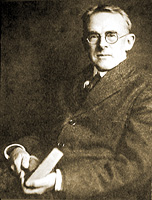
The Committee of Fifteen, wishing to change its complexion and enlarge its scope so as to invite the world to share the wonders of the Ojai Valley, appointed a committee on November 21, 1906, to perfect arrangements for the organization of a Board of Trade, and “moved to insert a notice in ‘The Ojai’ calling a meeting of the citizens on November 28th to effect the said organization.” Forty members signed up after paying fifty cents initiation fee and one dollar in advance as dues for the year. The first board of directors was E. S. Thacher, H. Waldo Forster, C. E. Gibson, E. F. Baker, W. C. Hendrickson, Joseph Hobart, F. P. Barrow, Dr. B. L. Saeger, J. J. Burke. The first officers were E. S. Thacher, president, H. W. Forster, vice-president, J. J. Burke, secretary, and E. F. Baker, treasurer. Advertising and Transportation Committees were appointed. Booklets were prepared with which to contact the world and were paid for by the county.
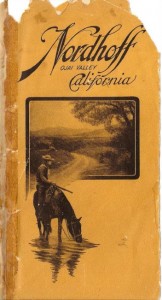
At one of its first meetings the board asked the merchants to write letters to the Southern Pacific Co. asking for better freight and passenger service, and suggested that “the merchants have all their freight come by water, which might be used as a lever to bring the So. Pacific Co. to time.” I wonder how many nights’ sleep the S. P. Co. officials lost over that dire threat.
In 1907 the possibility of getting electricity in the valley was discussed. The artesian wells along Ojai Avenue were deemed a menace to health. Four kerosene street lamps were ordered placed from the railroad station to Ojai Ave. and $25 was voted for this improvement. In 1908 subscriptions were taken to build a bridge across the San Antonio river near the Gally cottages. On April 1st, 1910, the Board of Trade directors favored unanimously the bonding of the county for good roads to the extent of $1,000,000, providing the Ojai Supervisorial District got its share. T. S. Clark was then our supervisor. The subject of building a high school, the minutes read, brought out the statement from Principal W. W. Bristol that a building built in the bungalow style, exclusive of the grounds could be constructed for $15,000. He thought it would be ten years before the school would have 100 pupils. (There were about 70 in 1920; the great fire of 1917 played havoc with any increase in population.) The last minutes of the Board of Trade were on October 11th, 1911.
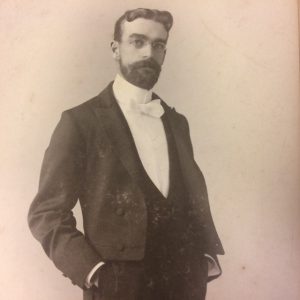
In the meantime the new high school was built and opened in the fall of 1911. The struggle over the site of the school was rather strenuous as between the east and the west side of town. When the people expressed their will at the polls the present site was chosen and like good Americans the fight was soon forgotten.
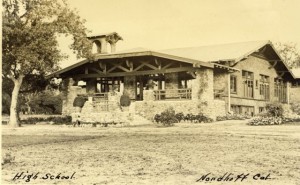
One day in the fall of 1912 Mr. Frank Weir called upon the writer and proposed a new organization whose purpose was the welfare and growth of the community. He proposed to call it “The Ojai Valley Civic League” and asked me to undertake the secretaryship. Mr. Weir was a very sick man, but energetic and full of enthusiasm for the Ojai Valley. He had in mind the opening of an office in Los Angeles to contact tourists and direct them this way. We collected from both men and women about $400.00. The matter of the Los Angeles office was out of the question. The money was spent mainly for 12 electric lights and their upkeep so long as the money lasted. Mr. Weir and the organization perished with him.
While we are waiting for another civic organization to spring up I wish to give you a picture of the rather crude conditions of living in the valley in the first decade of the twentieth century.
We had a telephone system. It was very intimate service. Central was the clearing house of the whole community and the operators were most patient and gracious in giving information. The time of day, the location of a fire, the time of Jones’ funeral, the time the mail arrives, has Mrs. Scott had her operation? have you seen my dog on the street? and so on. Sometimes we had to wait a good while to get our number, but on the whole it was a good service. There was no electricity in the valley. Kerosene and acetylene gas were used. In 1913 a local electric plant was set up. There were frequent break downs and the service closed at 10 o’clock. All evening affairs were regulated by that arrangement. The water supply was so uncertain that the householders had to have settling tanks to insure a constant supply. Joe Berry, walking up Ojai Ave. to the pump followed by his dog, was a familiar sight. Transportation was by stage and train. The stage came form Ventura via Creek road with no bridges to span the many crossings. In winter the valley was often completely isolated—sometimes for days at a time. The train had a morning leaving time, but there was not certainty as to when it would get back. Main street in Ojai was a mud hole in winter and terribly dusty in summer. There were very few automobiles owned locally. The stores were all wooden and some of them mere shacks. The wooden sidewalks were on different levels.
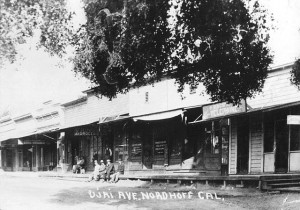
About 1914 Edward Drummond Libbey came on the scene in a magnificent way, but that is another story.
On April 24, 1914, a great meeting of the men of the valley was held at the village hotel— the Ojai Inn. Eighty-seven men were present. Sherman D. Thacher presided, and speaking and music was the order of the evening plus the memorable dinner arranged by Manager Joe Linnell, E. S. Thacher, J. J. Burke, L. R. Orton, Judge Wilson, E. D. Libbey and E. L. Wiest took part. The purpose of the meeting was to formulate some kind of a civic organization in succession to the Board of Trade. Since the Ojai Valley Woman’s Club was very helpful along civic lines, it was thought best not to ask them for support, hence the name Ojai Valley Men’s League came into being. Seventeen directors were elected on that night. The directors in turn elected Sherman D. Thacher, president, and Walter W. Bristol, secretary-treasurer. The directorate changed more or less every year, but the above named executive officers remained the same until 1927 when Mr. Thacher resigned and the writer was elected in his stead. At that time also the name was changed to the O. V. Chamber of Commerce.
To discuss the work of the Men’s League in full would be out of place here. Aside from lighting and cleaning the streets it stood ready to take the lead in every worthy enterprise. I will cite the year 1917. On April 6th of that year the Men’s League planned a day of celebration in honor of Edward D. Libbey, who had done so much to put the Ojai Valley on the map. The plan was to make it an annual affair to be called “Libbey Day.” Mr. Libbey did not accept this suggestion and it was thereafter celebrated, but was designated “Ojai Day.” It took the form of a basket picnic and was held in the Civic Center.
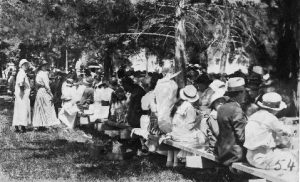
On this particular day in 1917 people came from all over the county. There was band music and community singing. A speaker’s stand was erected near the tennis courts. Mr. Libbey spoke and T. C. Stevens of Los Angeles, a warm friend of Mr. Libbey, was the principal speaker of the day. the climax of the celebration was a procession of about one hundred cars (quite a sight for that time) which, starting from the civic center, wound over the roads of Arbolada.
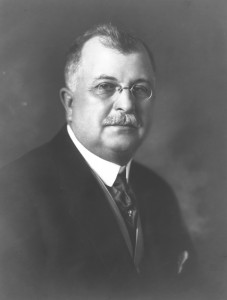
Just a few days before this celebration, March 30, 1917, the community met in the high school auditorium to honor Charles M. Pratt for the splendid gift to the community of manual training and domestic science buildings at the high school with complete equipment for each. The speakers were County Superintendent J. E. Reynolds, Felton Taylor, president of the student body, Principal Bristol and Sherman Thacher who presided.
The League under the able direction of its president, Sherman Thacher, did a good work in providing for the victims of the Spanish influenza. The Boyd Club was taken over for a hospital. Loring Farnum and Miss Sarah McMillian should be remembered for their services in this strenuous time.
In 1918 the League collected $374.00 for the purpose of a curb to curb pavement through town. About this time the directors of the League began agitation for the incorporation of the village. The boundaries were determined, the election called and incorporation was successfully carried in 1921.
It was the custom from the first for the League to have an annual dinner meeting. As I look back over the years these meetings stand out not only as one of the most important and enjoyable events of the year, but as a means of promoting a sense of unity and good feeling. The Chamber of Commerce still exists and should be a constantly greater agency for community betterment.
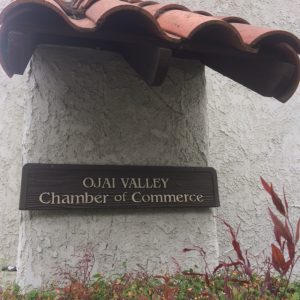
We today cherish the memory of the men and women who in days past established in the Ojai Valley a tradition of culture and local pride. This tradition must be carried on if this community is not to lose its distinctive qualities. Eternal vigilance is the price of such an achievement. “Where there is no vision the people perish.”
